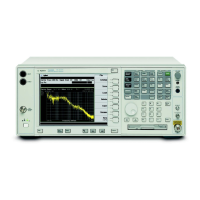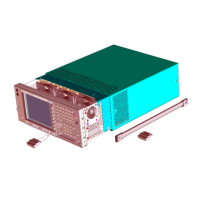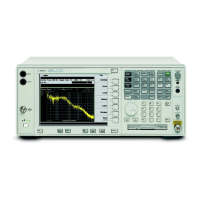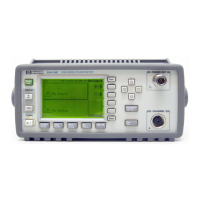Chapter 5 307
Programming Fundamentals
Programming Command Compatibility Across Model Numbers and Across Modes
Programming Fundamentals
Using Applications in PSA Series vs. VSA E4406A
NOTE This information only applies to the application modes:
Basic, cdmaOne, cdma2000, 1xEV-DO, W-CDMA, GSM, EDGE,
NADC, and PDC.
Command PSA Series VSA E4406A: A.04.00 VSA E4406A: A.05.00
*RST Resets instrument,
putting it in
continuous
measurement mode.
Use INIT:CONT OFF
to select single
measurement mode
and INIT:IMM to start
one measurement.
Resets instrument,
putting it in single
measurement mode.
One measurement is
initiated when the
command is sent.
Resets instrument,
putting it in single
measurement mode. No
measurement is
initiated when the
command is sent. Use
INIT:IMM to start one
measurement.
CONFigure:
<measurement>
Accesses the
measurement and sets
the instrument
settings to the defaults.
If you were already in
single measurement
mode, it takes one
measurement and then
waits.
Same as PSA.
Accesses the
measurement and sets
the instrument settings
to the defaults. If you
were already in single
measurement mode, it
takes one measurement
and then waits.
Accesses the
measurement and sets
the instrument settings
to the defaults. If you
were already in single
measurement mode, it
does not initiate a
measurement. Use
INIT:IMM to make one
measurement.
*ESE default Default is 255 which
means that every
error/status bit change
that has occurred will
be returned with a
*ESR? query. You must
set the value of *ESE
to choose only the
bits/status that you
want returned.
Default is 0 which
means that none of the
error/status bit changes
that have occurred will
be returned with a
*ESR? query. You must
set the value of *ESE to
choose the bits/status
that you want returned.
Same as VSA A.04.00.
Default is 0 which
means that none of the
error/status bit changes
that have occurred will
be returned with a
*ESR? query. You must
set the value of *ESE to
choose the bits/status
that you want returned.
*LRN The command is not
available.
The command is
available.
The command is
available.

